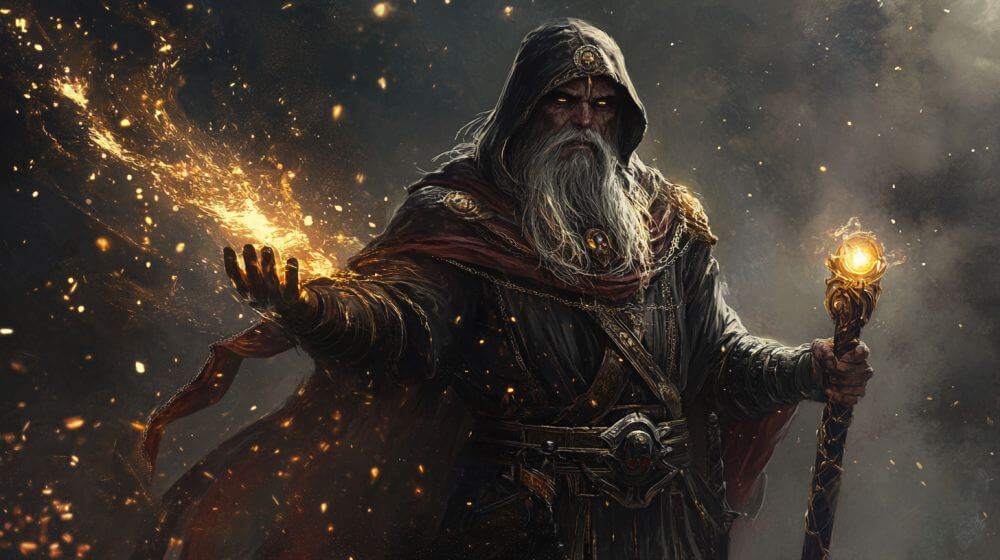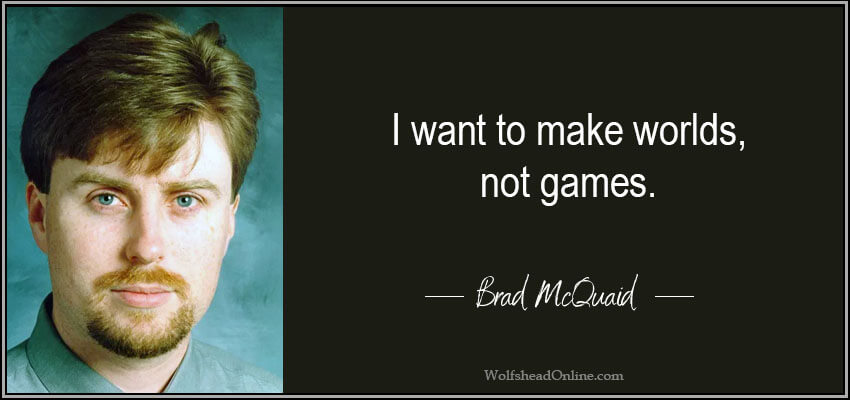The year 2024 A.D. was an important milestone in MMORPG History. EverQuest, the brainchild of Brad McQuaid and John Smedley had somehow survived for a quarter of a century. Over the years, there still remain a few video game pundits who ponder the impact that this fantasy MMORPG made on the industry.
Tragically Brad passed away from an unknown illness in 2019. Chris Rowan and Chris Perkins have picked up the torch and are keeping The Vision™ alive in their upcoming MMORPG Pantheon. Five years have passed and I thought it was time to dig a bit deeper into his philosophy of fantasy virtual world design. Let’s start with EverQuest.
In the Beginning, There was EverQuest
EverQuest was not just a game—it was an ethos, a living, breathing world built upon the precepts contained within The Vision™. Unlike the streamlined, user-friendly MMORPGs of today, EverQuest was crafted to be immersive, dangerous, and socially driven. It rewarded perseverance, punished recklessness, and encouraged cooperation.
But over time, MMOs strayed from this path. The genre became increasingly focused on accessibility, convenience, and instant gratification. Many of EverQuest’s most devoted players—those who thrived under McQuaid’s original design philosophy—felt abandoned as newer games discarded depth in favor of ease.

So what was The Vision™? And why do many MMO veterans still look back at it with reverence?
What Was The Vision™?
At its core, The Vision™ was McQuaid’s belief that an MMORPG should be a virtual world first and a game second. Players were not merely consumers of content; they were participants in a grand, unscripted narrative shaped by their choices, triumphs, and failures.
McQuaid also strongly respected Dr. Richard Bartle’s taxonomy of player types from early MUDs (Multi-User Dungeons), which categorized players into four distinct archetypes:
- Achievers – Players who chase levels, gear, and milestones.
- Explorers – Those who take joy in discovering hidden locations, lore, and game mechanics.
- Socializers – Players who form communities, make friends, and contribute to player-driven interactions.
- Killers (PvPers) – Those who seek competition, whether through duels or large-scale battles.
Unlike modern MMOs, which often cater primarily to Achievers and Socializers, The Vision™ ensured that all four archetypes had a meaningful role in EverQuest. Every system in the game—from its brutal corpse runs to its player-run economy—was designed to create a dynamic, interdependent society rather than a linear treadmill of content consumption.
Core Tenets of The Vision™
1. Risk vs. Reward – The Meaning Behind Every Victory
Modern MMOs have conditioned players to expect constant progression with minimal effort. Daily login rewards, quest markers, and near-instant leveling mean that even the most casual players can reach the level cap without truly engaging with the game’s mechanics.
EverQuest, on the other hand, demanded commitment. Every level gained required real effort. Every item earned had meaning because it was never handed to you; it was fought for, struggled over, and celebrated once acquired.
The game’s harsh death penalty—where players lost experience and had to recover their own corpse—wasn’t just a punishment; it was a motivator. It forced players to play smart, to assess risks carefully, and to treat each encounter with caution.
- Achievers thrived in this environment because advancement wasn’t trivial.
- Explorers loved the danger, knowing that uncovering new lands was a genuine risk.
- Socializers found meaning in the bonds formed through hardship.
- Killers relished the high stakes of PvP servers where a mistake could be devastating.
This risk-reward balance made EverQuest addictive—not because it handed out rewards, but because it made players earn them.
2. A Living, Persistent World – Where Actions Mattered
Most modern MMOs feel like scripted amusement parks—players are funneled from one attraction to another with little room for improvisation. But EverQuest was designed to feel like a real world, where player actions had lasting consequences.
- Factions mattered – Killing orcs in Crushbone might make you a hero in Kelethin, but it could also turn other factions against you.
- The world was static yet evolving – Players changed the economy, shaped the social order, and built reputations that followed them.
- There were no quest markers or exclamation points – Players had to read dialogue, pay attention to clues, and rely on each other.
Every interaction in EverQuest contributed to the sense that you were a participant in a living ecosystem, not just a visitor in a game world.

3. Class Interdependence – No One Stands Alone
Most modern MMOs allow players to solo their way to max level. But in EverQuest, grouping wasn’t just encouraged—it was a necessity.
- Warriors needed clerics to survive.
- Wizards needed enchanters to maximize their mana efficiency.
- Rogues relied on tanks and crowd control to unleash their full damage potential.
This forced players to interact, build friendships, and rely on social reputation. If you were known as a competent tank, a reliable healer, or a selfless enchanter, you were remembered.
By removing the ability to be self-sufficient, The Vision™ created a true multiplayer experience, where community wasn’t an afterthought—it was the entire point.
4. Harsh Consequences and the Power of Loss Aversion
One of the most overlooked aspects of The Vision™ was how it leveraged loss aversion—a psychological principle stating that people are more motivated to avoid loss than to acquire gains.
- In EverQuest, death meant losing experience, and in extreme cases, de-leveling.
- Corpse runs could leave you stranded and vulnerable.
- Losing rare gear in a bad situation could mean hours or even days of effort gone.
This created real tension in gameplay. Every dungeon crawl, every pull, and every boss fight carried a sense of danger and weight that modern MMOs lack. It wasn’t just about what you could gain—it was about what you stood to lose.
Loss aversion made victories feel more meaningful, and it also reinforced player cooperation. Who would you trust with a resurrection when your body lay deep in a dungeon? Who would help you retrieve your lost items? These were the social dilemmas that built bonds between players.

5. Exploration and Discovery – No Handholding, Just Adventure
Most MMOs today guide players by the hand, marking quest objectives, fast-travel points, and even loot locations. EverQuest did none of this.
- There were no in-game maps—you had to navigate by landmarks.
- Secret zones and items existed for those who dared to explore.
- Players had to talk to NPCs and read—not just follow a blinking marker.
This meant that every discovery was real. Finding a hidden dungeon or stumbling upon a powerful quest wasn’t just a matter of following a waypoint—it was a genuine achievement.
6. Massive World, Minimal Instancing – A Shared Experience
Unlike today’s MMOs, where players are segmented into instanced versions of dungeons and raids, EverQuest was a persistent world.
- If you wanted to kill a rare boss, you had to race against others or negotiate with rival guilds.
- Dungeons were shared spaces, meaning encounters with other players were unpredictable and organic.
- Competition over resources and enemies created emergent gameplay.
This unstructured, unscripted interaction made every moment in EverQuest unique—because other players weren’t just spectators; they were part of your story.
7. Player-Driven Social Bonds – The Heart of the Experience
Perhaps the greatest success of The Vision™ was that it fostered real social interaction.
- Players formed friendships that lasted years because the game required cooperation.
- There were no automated matchmaking systems—players built their own communities.
- A good reputation mattered, because grouping with known players was far better than trusting strangers.
This was MMORPG social gameplay at its peak. Players weren’t just soloing in parallel—they were building relationships, crafting player-driven narratives, and shaping the world together.
Why The Vision™ Still Matters Today
MMOs have lost something in their pursuit of accessibility. The shift toward solo-friendly content, linear progression, and convenience has eroded the sense of community, challenge, and discovery that once defined the genre.
McQuaid’s The Vision™ remains a blueprint for how MMOs can reclaim their soul. As modern developers seek to recapture the magic of EverQuest, they would do well to remember that a real virtual world isn’t just about ease of access—it’s about meaning.
–Wolfshead




I have fond memories of EQ…friends who printed their own maps and built up 3 Ring binders…playing for an evening meant setting up notebooks, pages, and if you were lucky…you had recent cut sheets from primitive online resources like allakazahm which showed you some of the necessary items, quests, and recipes for advancement – ALL based on shared knowledge of those who’d been before you and took the time to send back messengers. It was a great experience, and one that I must admit I long for as many others do…and haven’t found in anything attempted since 1999.
Brad McQuaid deserves a lot of credit for what he and John Smedley achieved with EverQuest. The Vision was a remarkable philosophy. You don’t hear much about it anymore which prompted me to write about it and attempt to codify it in words. I only wish he would have been better at execution (Vanguard and Pantheon).
It’s a shame that he left SOE (or was forced out) and stumbled so much after that. I wrote a lengthy article about his trials and tribulations a few years ago that was not a flattering picture of Brad. However, his heart was in the right place.
The current EQ dev team has no clue about the Vision and probably could care less.